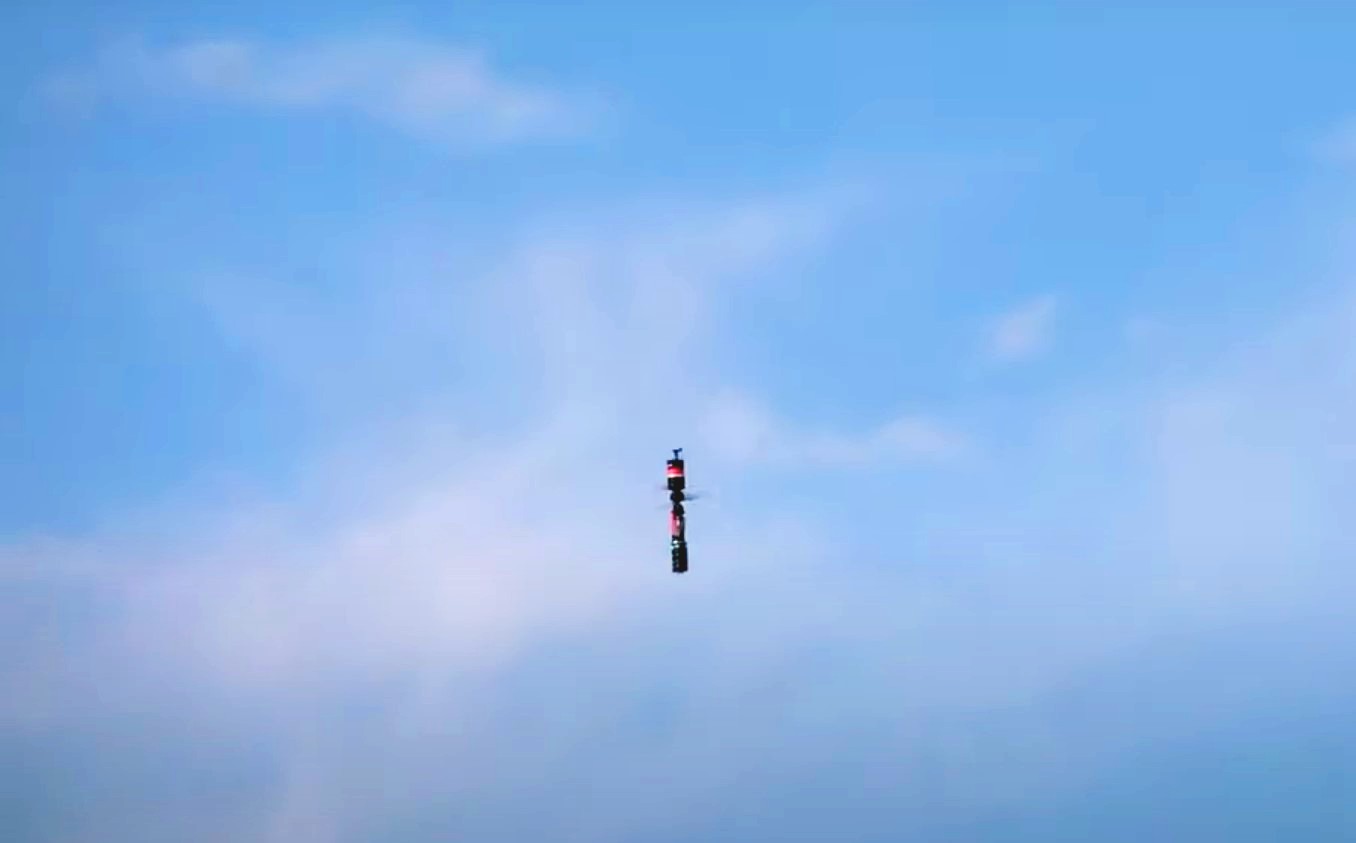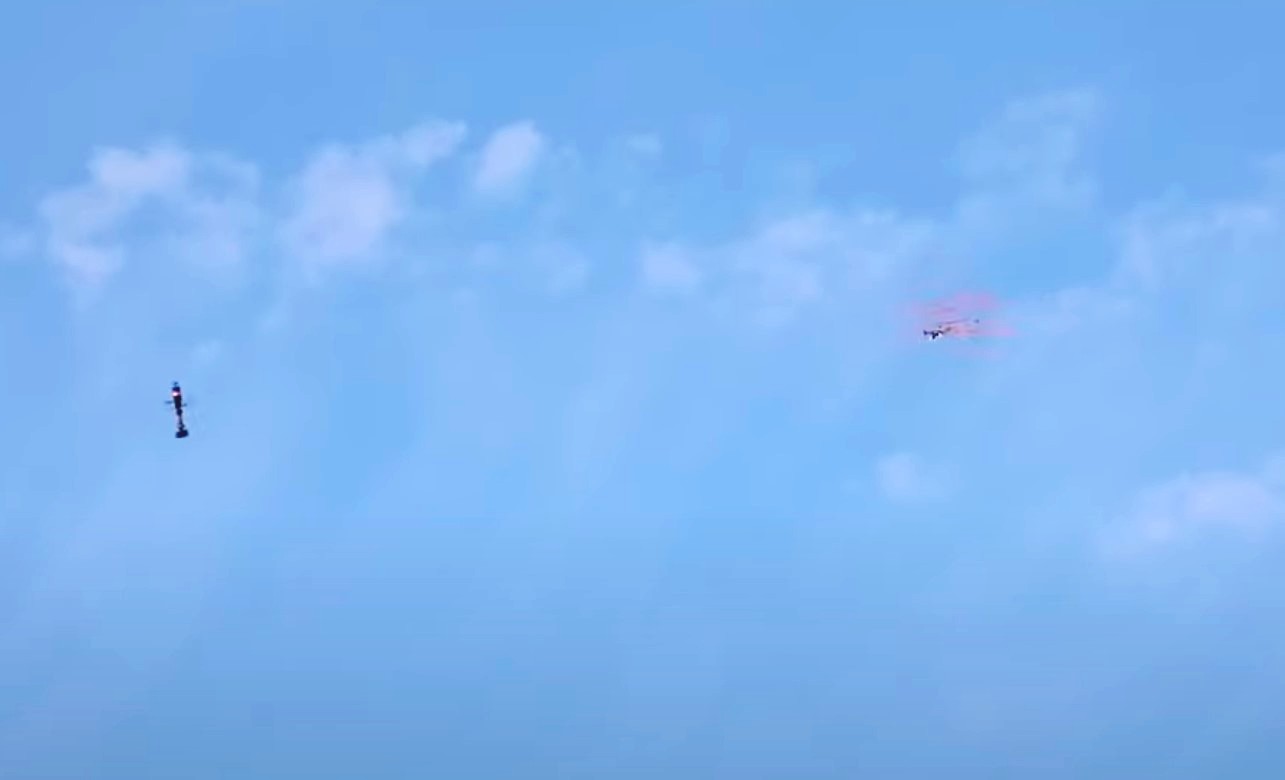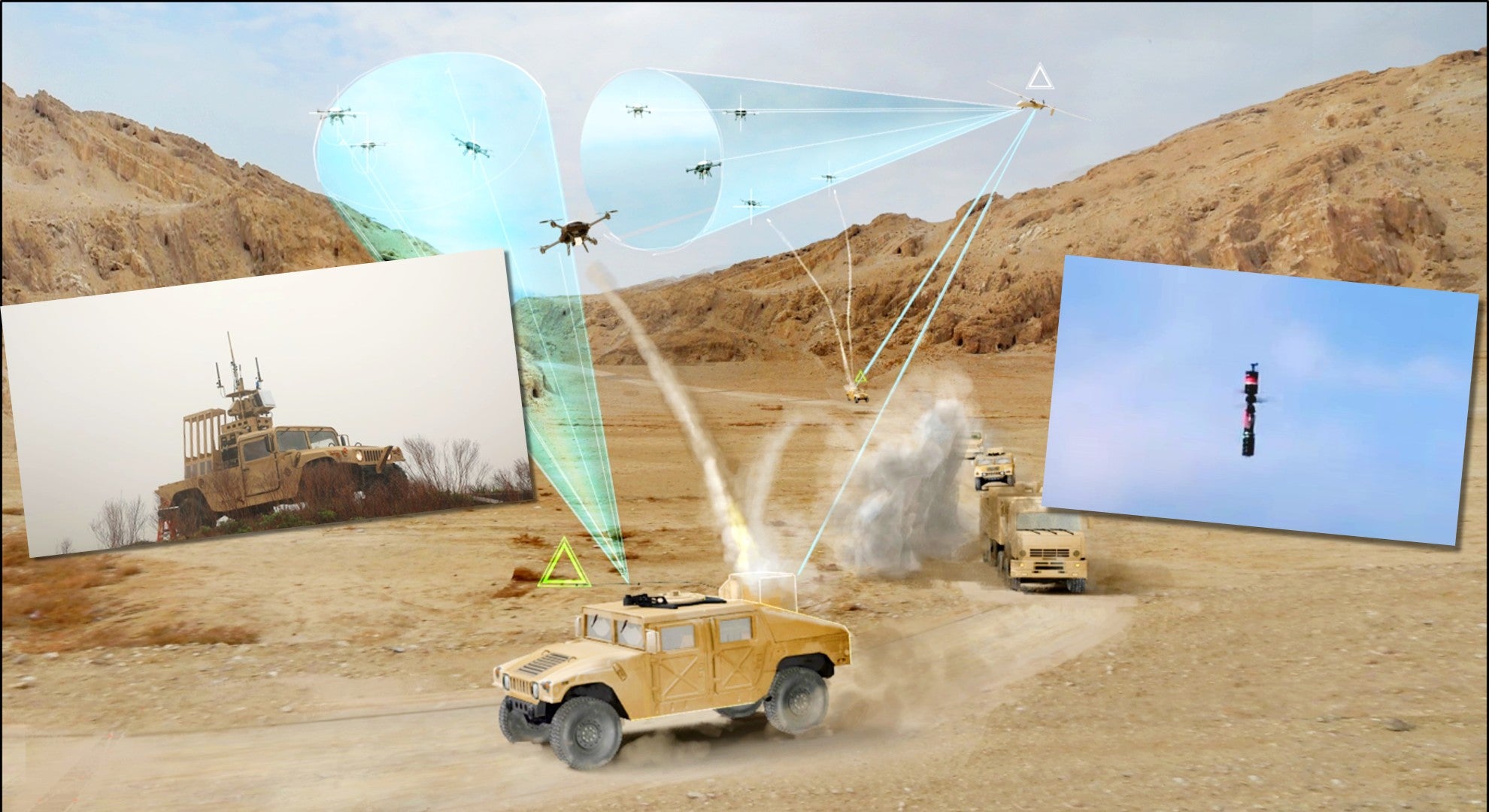DARPA has shared a video of a recent demonstration of a system it is developing as part of its Mobile Force Protection program, or MFP. The demonstration tested a novel counter-drone concept that launches reusable interceptors that shoot what DARPA is calling “strong, stringy streamers” directly at adversary drones in order to foul their propulsion systems and cause them to fall from the sky. The system, as it exists now, is primarily intended to offer a way to protect convoys from small drones while avoiding or minimizing collateral damage by not using high-explosives to take down incoming threats. DARPA also states the system can defend military installations.
The recent demonstration was conducted at Eglin Air Force Base and saw the MFP technology demonstrator successfully neutralize “tactically-relevant drones.” In the footage DARPA shared to YouTube, the MFP interceptor can be seen bringing down a single quadcopter drone using a blast of its “stringy streamers” which appear to clog the drone’s rotors to the point of complete loss of lift a few seconds after impact.

The new MFP system in DARPA’s recent demonstration was mounted onto the back of a Humvee and seems to include a sophisticated sensor suite in addition to at least four, or possibly eight, interceptor launch tubes. DARPA states that the system uses a novel X-band radar system that is claimed to be able to automatically sense and identify UAS targets. The system then uses “an automated decision engine” to match those targets to specific interceptors in its inventory without the need for a human operator to manually launch those units.
DARPA’s press release mentions the MFP system consists of both rotary and fixed wing interceptors that employ two types of drone countermeasures, but the accompanying footage depicts only a rotary wing interceptor launching the stringy anti-rotor countermeasures specifically mentioned in the release. It’s unknown what other type of countermeasures are used in the MFP system, but the press release states that “non-kinetic techniques were developed and demoed.” Propellers and rotors are, by far, the most common means of propulsion for small drones, commercial and military, on the market today. It’s unknown how well the system might work on drones potentially featuring other forms of propulsion, but such a concept could presumably foul the intakes of small jet engines or any articulated control surfaces found on drones as well, if it could hit them.

“Because we were focusing on protecting mobile assets, the program emphasized solutions with a small footprint in terms of size, weight, and power,” said Gregory Avicola, DARPA’s MFP program manager. “This also allows for more affordable systems and less operators.” In a press release accompanying the footage, DARPA explained that the focus was on “defeating raids with multiple threats, rather than single unmanned aerial attackers” by focusing on sensors and autonomy. The system is even claimed to be safe enough to use in and around populated civilian areas, which is a massive advantage.
The MFP program began in 2017 with DARPA awarding Phase 1 contracts to three contractors: Dynetics, Inc., Saab Defense and Security USA, and SRC, Inc. In addition, DARPA also worked with the Department of Homeland Security’s Science & Technology Directorate and the U.S. Coast Guard on developing the MFP system.
In DARPA’s most recent announcement of the successful demonstration, Dynetics was reported to be the primary systems integrator on the MFP project. Dynetics has previously developed highly ambitious swarming drone systems for the Department of Defense (DOD). According to a Dynetics fact sheet about the MFP program, the system can detect small unmanned aerial systems (sUAS) at a distance of 1 km or greater, and “disable or destroy numerous self-guided sUAS” at those same distances. Dynetics reports the system is “highly autonomous.”

In DARPA’s recently-released Fiscal Year 2022 budget request, the agency is reported to have requested $12 million for the program in FY2020, and just $4.3 million in FY2021. According to DARPA’s budget estimate documentation, FY2021 plans include “additional open-air demonstrations that include realistic threats, performance models, signatures, networks, and environmental factors.”
No funds were requested for FY2022, as the program has reached completion.

Similar kinetic C-UAS systems have been developed and demonstrated in recent years as the threat from small drones and/or swarming drones continues to increase. The U.S. Army has previously purchased Raytheon’s Coyote UAVs in order to provide an anti-swarm solution, and we have previously reported that the DOD has purchased other kinetic anti-drone systems that use drone interceptors made by Anduril Industries. The U.S. Air Force, meanwhile, has previously purchased special shotgun shells that, when fired, expand into a net in order to snag hostile drones similar to DARPA’s new rotor-tangling streamers, and Lockheed Martin has developed small munitions capable of bringing down small drones or artillery rounds.
While DARPA has said that the goal of the MFP program is to “protect high value convoys,” from the look of the system shown in the demonstration, it seems there’s no reason why it couldn’t be palletized and deployed in a number of scenarios including surface vessels, forward operating bases, or even for protecting critical infrastructure from drone attacks.
One thing that remains unclear is whether or not each interceptor in the MFP system is designed to engage multiple drones or not, given that it is clear that one of the most looming airspace defense concerns is swarm defense. Taking down one drone with an interceptor could be useful in small-scale attacks, but what do you do in response to mass attacks or swarms? How many MFP drones would be needed to defeat or disable a hostile swarm?
The footage DARPA shared seems to show either four or eight interceptor launch tubes per MFP unit, but one can easily imagine an adversary putting together a swarm of more than four or eight drones with minimal investment and easily available commercial technologies. Such tactics are already being used by criminal organizations and peer-states alike. Of course, there’s no reason that multiple MFP systems couldn’t be deployed side-by-side, or that the system in shown in the recent demonstration at Eglin AFB couldn’t be sized up to feature more interceptor launch tubes. There’s still a question of overall capacity, however, and though the interceptors are stated to be reusable, it’s unclear how long it takes to recover, rearm, and redeploy each one.

Clearly, while this is a novel idea, and DARPA’s demonstration appears to have been successful, there are questions about just how broadly applicable the system is to the current challenges at hand in terms of swarming drones. Cost is also a factor: how expensive is each individual unit relative to the protection it offers? DARPA’s program manager has stated that the MFP system was designed to have a small footprint, both physically and in terms of cost, but one can imagine that a large number of MFP units would be needed to protect a large force or installation from the threat of a sizeable swarm or multiple swarms.
The investment into systems like DARPA’s Mobile Force Protection program are in clear response to the growing threat posed by unmanned aerial vehicles, suicide drones, loitering munitions, swarming technologies and the current shortfalls in terms of defending against them. Even small, modified commercial quadcopters represent a very real and asymmetric danger against military installations and operations, a danger that is sure to grow as these technologies continue to get cheaper and more capable.
“These small- and medium-sized UAS proliferating across the [area of operations] present a new and complex threat to our forces and those of our partners and allies,” U.S. Marine Corps General Frank McKenzie, head of U.S. Central Command (CENTCOM), declared to the House Armed Services Committee earlier this year. “For the first time since the Korean War, we are operating without complete air superiority.”
To that end, the US military is exploring a wider array of counter-drone systems, as well, and the MFP system, if transitioned into deployment, would almost certainly be just one part of a future layered defense. Systems such as DARPA’s MFP could provide a standalone solution for lower threat areas, but could also add another valuable layer of air defense in a far more dense threat environment. For a more robust and comprehensive drone defense solution, the DOD and military leadership are examining a wide range of C-UAS concepts including netting or fencing around installations, directed energy solutions, or methods to sever command and control links between drones and operators.
“We’re open to all kinds of things. The Army is working it very hard. Still, I don’t think we’re where we want to be,” McKenzie recently said.
We have reached out to DARPA for comment about the MFP program and will update our reporting as more information surfaces.
Contact the author: Brett@TheDrive.com
